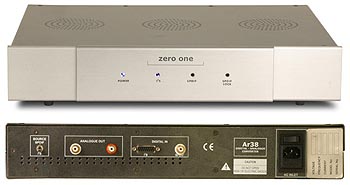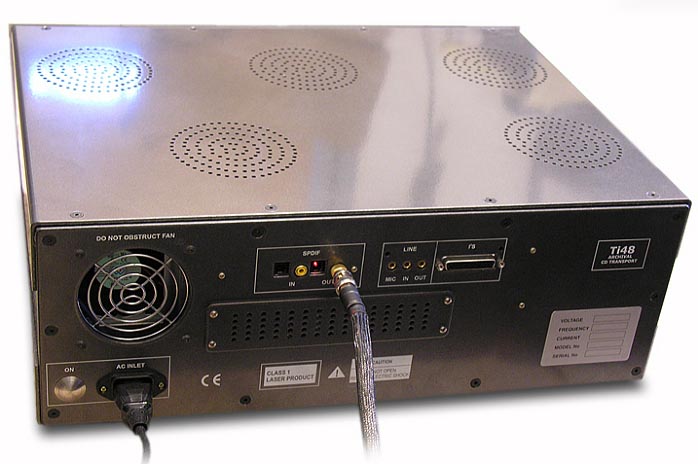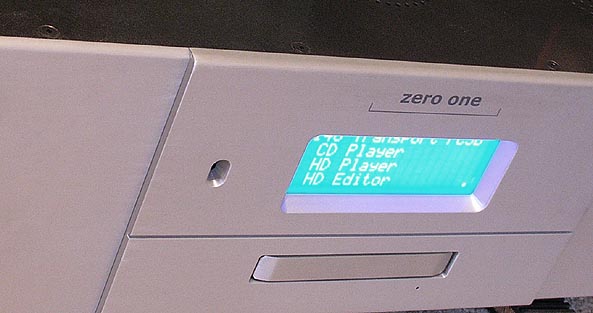|
This review page is supported in part by the sponsor whose ad is displayed above
|
|||||||||||
 |
|||||||||||
| Setup & use |
|||||||||||
 |
|||||||||||
| I'm not going to bore you by going too deeply into the use of the Ti48 except to offer assurance that it's not difficult. If you can use your computer to read this review, you can operate the Ti48. Upon insertion of the CD, you press the "Menu" button on the remote and the Ti48 asks to be informed of your intent. Use the directional arrows on the remote to scroll down the menu until you can input the desired info. "CD Player" is the first option and the one you choose if you just want to play an inserted CD. Scroll down once more to "HD Player" to play something archived on the hard drive. If you choose to play a CD, operation becomes much the same as you're used to. If you choose | |||||||||||
| to retrieve hard drive data, you simply direct the Ti48 to the archived selections. That can be done in a number of ways. You can scroll manually through the menu of archived CD titles or you can alphabetically skip through groups of titles with the numeric buttons on the remote. Either way, it's easier and likely faster than getting up from your chair, searching through rows of CDs in your library and manually inserting a disc into the player. |
|||||||||||
 |
|||||||||||
| Archiving CDs is pretty easy. Place a CD in the drawer and two commands later, choose "grab CD" from a menu to automatically rip the CD to hard drive. Greatly facilitating the archival process is the fact that the Ti48 contains a CD-recognition software known as EmDB. This is a compressed version of the FreeDB database available on the Internet: www.freedb.org. EmDB recognizes hundreds of thousands of CDs, provides information on the artist/group name, the album title and, in most | |||||||||||
 |
|||||||||||
| cases, track titles as well. The general public has entered all this information into the FreeDB database. Because FreeDB is a continually updated affair, Zero One Audio promises to release a CD-ROM update on a quarterly basis. CD ripping is accomplished at 4X speed. 4X? I have to confess that I was a bit surprised by the speed at which the Ti48 harvests the ones and zeros for transplant to hard drive for perpetuity. I've heard of systems that archive data at speeds substantially slower than normal playback - systems that pour and ponder over the bits in successive passes in an attempt to eliminate the possibility of errant info bits. I asked Alvin Heng to comment. "Employing repetitive re-reading of sectors is actually counter-productive with our drive as it creates more jitter. Our ripping quality has been compared to EAC with discs in good condition and from different pressing plant. All Ti48 copies were confirmed bit-for-bit identical." Well, that's just about what we'd expect him to say. However, by the time I put the question to him, I'd already done substantial listening. At the risk of tipping my hand at this juncture, I already knew that something special was going on. No matter the explanation or theory, it was obvious that even at 4-times speed, the Ti48 was indeed getting the job done. My question then was not as much a challenge of Zero One's engineering assumptions or decisions but more of a head-scratching "How'd they do that?" Of course, the most vexing remaining question was this: if the archival data was a perfect copy of the CD in the drawer, why did it sound so much better streaming off the hard drive? Alvin Heng continued: "One of the reasons that people think that HD [hard drive] audio is better than CD drive playback is that the error correction of the CD drive as it plays music straight off the disc modulates the power supply. Even very good CDPs have their power supplies connected at the IEC mains inlet (and most are connected more directly via the same transformer. Here the noise coming from the servos can bleed through to the analog sections of the DAC. This would be the least of the problems faced by a CDP that has to play music straight off a rotating, flapping disc. Why does HD audio sound better? We don't really know and we don't have the research budget to do the testing (maybe one day). The reasons may include some or all of the following: 1) much tighter tolerances on the HDD than on a CD |
|||||||||||
 |
|||||||||||
I could go on and on about the day-to-day operation of the Ti48 but there's really no need. Once acclimated to it, I found it easy and intuitive to use. And to say that I got used to the virtual flipping through of CD after CD from the comfort of my listening chair would be a grave understatement. At the end of the day, not seeing CDs and jewel cases all over the floor was bloody splendid. The Ti48's utility wasn't restricted to enjoying laziness, however. Like no other transport I know of, the Ti48 offered an unprecedented amount of playback flexibility. Have you read about the damaging effects of the Redbook brickwall filter? The Ti48 allows you to listen with the typical filter in place or select from four variations on the theme, each with a different filter contour. Hint: any or all contours sound better than the one specified by Redbook. The subtlest of these adjustments results in a sonic change that's anything but subtle. How about word length and upsampling and their seemingly over-hyped effects? The Ti48 allows you to give 16, 18, 20 and 24-bit a try along with sampling rates up to 96KHz (192kHz only via I2S output). Of course to be useful, your DAC will have to be fully compatible and accept an upsampled data stream. I found all three of these options very useful. From what I gather, they are somewhat system-dependant so my personal preferences are unimportant. What is important? The options are not only useful but also easily demonstrable. If my experience is indicative, any change from "standard" results in audible improvements. As you move up the ladder, these incremental improvements simply stop at a certain point. I've not ever observed them going backwards but the improvements do hit a wall. When I reached that point, I stopped playing around. One can also invert phase as well as choose from a variety of dither options. For an explanation on dither, I thought it best to readdress Mr. Heng: "The Ti48 transport performs all its audio processing at 64-bit. In order to transfer the resulting data to a D/A converter, the samples need to be reduced. This is commonly known as "word length reduction". If the data was simply truncated to the requisite D/A length (for example, 16 bits), this results in quantization distortion. To avoid this, a small amount of noise is introduced before reduction takes place. This is known as "dither". In order to make dither noise less audible, it can be tailored to make it louder where the ear is less sensitive, quieter where the ear is more sensitive. This is known as "noise shaping". The Ti48 offers a variety of word length reduction modes: None - no dither; TPDF - triangular PDF dithering; Nyquist - high frequency dither; and NShape - second-order noise shaping." |
|||||||||||
 |
The important thing to remember from all that? The Ti48 offers unprecedented flexibility when it comes to tailoring the sound to your room, system and listening tastes. Differences were easily heard and easily achieved. If a change floats your boat, use | ||||||||||
| it. If not, scroll back one setting and forget about it. With the Ti48, experimentation is cheap. I've now established that the Ti48 is pretty easy to use, fairly easy to learn and super easy to operate once you've traversed its learning curve. So how does it sound? In a word, magnificent. There's no reason to be coy here. I'll just say that once a CD is stored in its archive, the Zero One Ti48 outperforms every transport I've ever used, including my own reference. Significantly, notably and embarrassingly. | |||||||||||
 |
 |
||||||||||
 |
|||||||||||